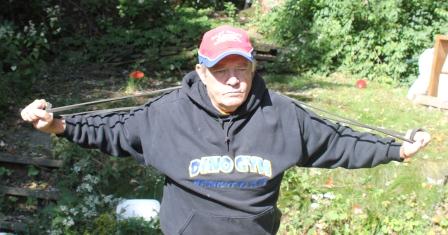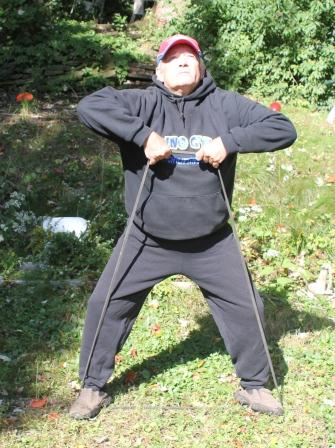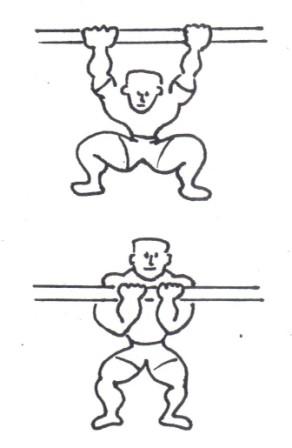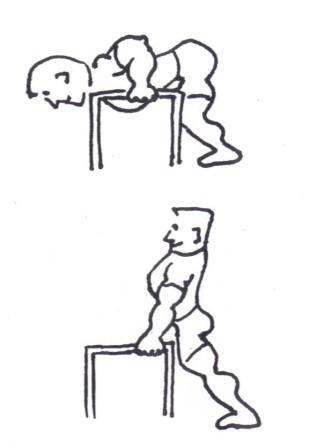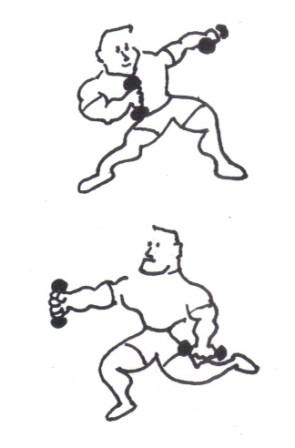Resorteras, Rehab, and Records
by John McKean
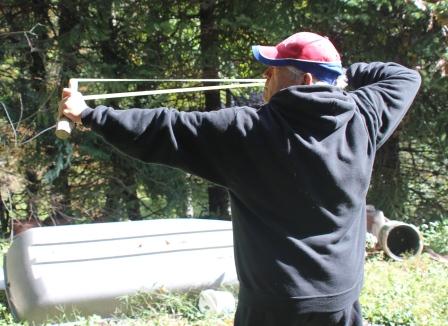
John McKean in the shooting position with his resoteras. A strong pull is needed, which works both the triceps and delts.
“THWACK!!!” A golf ball left mighty Paul Anderson’s tee after a typical set of ten with 800 pounds on the squat. You see, it is said that ole Paul had a three hole golf course set up on the grounds of his famous youth home, and he’d play the holes in between sets! This proved to be ideal “active rest”, well deserved fresh air, and much needed recuperation for the strongest man of all time.
“THWACK!!!” This is the noise that my nosy next door neighbor may hate worse than the clanging weights resonating from my open garage door. No, I’m not a golfer, but get this similar sound effect while target shooting my “resortera”, a Mexican term for a homemade, powerful, hunting-capable slingshot. Last year I renewed my acquaintance with slingshot target work, and find it a very relaxing, yet exercise oriented way of calming down from heavy, home gym lifts. The outdoor few minutes, alone ( I don’t rest quite as long as Paul Anderson did!) seems to energize me into better lifting efforts! Certainly the equipment is easy to acquire – the “resortera” concept dictates that you build your own slingshot from tree branch “Ys” (or cut from board or metal- a hunter/lifter/builder like Al Myers would probably weld one from thick steel to keep it HEAVY !), basic office rubber bands, and stones,marbles, or hexnuts for “ammo” (easy instructions for building lots of variations can be goggled at rebelslingshotforum ). I can attest to an actual increase of tone in my arms, delts, lats, and pecs from this unique band work (With the powerful hunting set up of seemingly simple office type rubber bands, a slingshot pull can get rather intense. You should see the wild game that my friends Jamie, Nico, Chepo, and Xidoo acquire with their homemade killing machines!) and nutrition habits (pizza!) of son, Rob,keeps me well supplied with cardboard boxes that serve as targets on my outdoor ” range”!
Now in terms of bands, always a favorite subject of mine, the slingshot was not my only rubber training tool during this past summer. I’d been having really spirited productive lifting sessions early on, but was out fishing (another favorite outdoor activity- I tease Big Al by telling him that the fish I catch are so big & plentiful that I should apply for a “fish lift” category in the USAWA!) and once found my foot shifting quickly on a hill over loose gravel; well,both the right knee and left lower back went into sudden ache mode,and stayed that way. Even a few days off, and a serious visit to my chiropractor didn’t give much comfort. But, heck, there were meets approaching and records to set, so I just couldn’t take a long layoff!! While limping out to fire my nifty, homemade driftwood resortera one morning, I began to formulate a plan as the fresh air did its usual magic to invigorate me. I’d simply start all lifting sessions with Dr. Len Schwartz’ “Longstrength” concept, via Jumpstretch’s medium strength “mini-monster” bands. I did 50 reps with 2 bands over my shoulders for braced squatting, cable pulldowns while lunging toward my wounded knee for 35-45 reps, back presses while lunging over the other knee, high pulls along with wide squats, lying cable flys with leg pull-ins, and good morning bends + tricep pushes with the band over my neck. All light resistance, high rep combination style movements (which is the Longstrength concept) that really “gave an excuse” for blood to flush into the wounded areas. The fast paced 250+ reps also served as the best lifting warmup I’ve ever done!
My main workout,of course, had to be treated with “kid gloves”. The slingshot breaks kept me from getting really crazy (all you who know me, keep the laughter down and continue reading!!) , with restoring fresh air allowing time for common sense to intervene. So I’d take some of our most stable all-round lifts and do them in as perfect form as I could, adding control and slower tempo by placing a flex band over the bar (as I’ve displayed in past articles). With a single “mini-monster” band, I needed only to do a few singles up to about 60-70% of an anticipated record lift, that I was planning for the Fall meets. Often, especially if the knee or back started hinting that they were uncomfortable, I’d do the lighter build up singles without a band, then place it over the barbell to repeat the final top weight for the day for just that set. Usually a lift was completed in 4 easy sets (singles), and the five lift workouts were performed quickly with minimum agony.
As an aside, Dr. Schwartz often warned me that his Longstrength system was potent medicine. Shortly before his death (he was still exercising daily at 84 and could perform 35 consecutive, perfect chinups!), we’d had numerous spirited discussions on the great value of flex bands to supply constant tension during the fitness building, combination exercises.We even concluded that rubber cables fit in perfectly with his “moving isometrics” strength-aerobics concept. Yet I was still totally shocked to discover that my rehab program, seemingly quite mild, had reduced me to the middleweight division!
As I write this, I’m now mostly pain free and all set to try those records at Art’s Birthday meet in a few short days! Recent workouts, still with the same minimal approach, have been going great with emphasis on the prime commandment for Master’s lifting -” Thou shalt not injure thyself during training, ever! ” Now, if only I don’t go outside and catapult a 200 fps rock into my thumb, I’ll be in fine shape!
